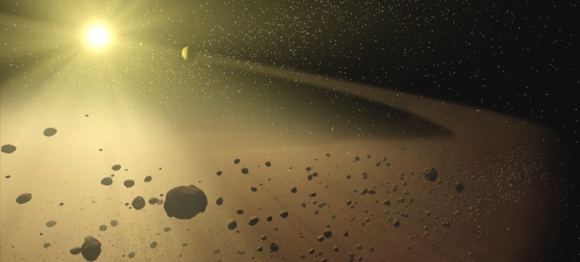[/caption]Where do asteroids come from? Most of them are grouped in the main belt, but that is not the only asteroid field in the solar system. There are actually four sets of asteroids grouped into different fields: the main belt, Trojans, scattered disc, and the Kuiper belt. To understand where do asteroids come from, you need to know the theory on how they were formed.
Most scientists agree that all of the asteroids are the result of the the big bang. After the initial turmoil, large asteroids collided together and through the process known as accretion planets and dwarf planets were formed. The planets and dwarfs grew large enough to develop gravity and became rounded and able to sustain their own gravity. Asteroids continued to collide and destroy each other until we have the elliptical and other odd shaped, pock-marked solar objects that we have today. Here is a little information to help you understand where do asteroids come from today.
The asteroid field known as the main belt is a large collection of objects that are in orbit between Jupiter and Mars. The largest known asteroid in the belt is Ceres which accounts for 27% of the belts’ total mass. Ceres is also the only asteroid in the belt that is classified as a dwarf planet. Vesta, Hygeia, and Pallas are the other of the four largest bodies in the asteroid field. There have been several space missions that have crossed the field. The asteroids are far enough apart that traversing it is easily done. The Dawn space mission to the next to visit the main belt and will visit two of the largest bodies, hopefully it will be able to help reclassify Vesta as a dwarf planet.
The Kuiper belt is populated with thousands of icy bodies. The only one that is currently designated as a dwarf planet is the former planet Pluto. That may change in the near future since there are at least two bodies in the belt that are larger than Pluto. Our ability to send spacecraft that far out is what is holding us back right now.
The Trojans asteroid field, originally referred to the Trojan asteroids, orbits around Jupiter’s 4th and 5th Lagrangian points. Subsequently objects have been found orbiting the same Lagrangian points of Neptune and Mars. The word Trojan, in astronomy, refers to a natural satellite that shares an orbit with a larger planet or moon, but does not collide with it because it orbits around one of the two Lagrangian points of stability.
The scattered disc asteroid field is a subset of the Kuiper belt. Because their orbits take them well beyond 100AU from the Sun they are the coldest objects in the Solar System. Due to its unstable nature, astronomers now consider the scattered disc to be the place of origin for most periodic comets. Many of the objects in the Oort cloud are thought to have originated in the scattered disc.
Answering the question: ”Where do asteroids come from?” is pretty easy, but it is ambiguous at the same time. What we have are mostly theories and few definite facts. Things get even more blurry as you study different asteroids and find that some from different belts have somehow inter-mixed. Ah, the beauty of astronomy!
There is some good info on the asteroid belt here. NASA has a good piece on KBO’s. Here on Universe Today there is an article on the possibility of an alien asteroid belt and the Milky Ways’ own asteroid belts.
Reference:
Wikipedia

